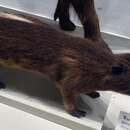en
names in breadcrumbs


Despite their rodent-like appearance the hyrax have been placed in their own group due to their unique characteristics. However, their closest relatives are believed to be Proboscidea (elephants). Both have developed a pair of upper incisors that are used as defensive tusks. Secondly the hyrax had flat nails on their feet that resemble the hoofs of elephants. According to amino acid sampling, these two groups are closely related as well.
Perception Channels: tactile ; chemical
The status of the tree hyrax is said to be rare. Although not endangered, they are thought to be threatened due to habitat destruction.
US Federal List: no special status
CITES: no special status
IUCN Red List of Threatened Species: least concern
The soft furs of the eastern tree hyrax are sold for a high price value in many regions.
Unlike the other species of hyrax, the tree hyrax is a nocturnal forager. It is mainly herbivorous, feeding on leaves, fruits, bark, twigs, and grasses as well as an occasional insect.
The tree hyrax inhabits mainly forest areas forming a band across mid-Africa extending from the eastern to the western coast.
Biogeographic Regions: ethiopian (Native )
Tree hyraxes inhabit various regions ranging from wooded areas and savannas to coastal dunes and tropical rainforests.
Terrestrial Biomes: savanna or grassland ; forest ; rainforest ; scrub forest
Average lifespan
Status: captivity: 5.5 years.
This rodent-looking mammal has short ears and legs, thick, soft fur with gray-brown to black colorings. The hyrax has a distinct patch of lighter colored hair on its back which covers a scent gland and bristles when the animal is excited or mating. Typically the tree hyrax is about 1-2.5 feet in length, has a height at the shoulders of 10-12 inches.
Range mass: 1 to 5 kg.
Other Physical Features: endothermic ; bilateral symmetry
The tree hyrax has an unusually long gestation period for its size; ranging from 6.5 to 7.5 months. Sexual maturity is reached around 16 months of age. Litter sizes of 1-2 are common, unlike the larger litters of other hyraxes. The young are born fully furred and rather large. By the age of one day they are competent climbers. There is little data on the mating systems of these animals due to their nocturnal lifestyle, however it is believed that within the small groups there is one dominant male and the rest of the males form bachelor herds.
Key Reproductive Features: gonochoric/gonochoristic/dioecious (sexes separate); sexual
The western tree hyrax (Dendrohyrax dorsalis), also called the western tree dassie or Beecroft's tree hyrax, is a species of tree hyrax within the family Procaviidae. It can be distinguished from other hyraxes by short coarse fur, presence of white patch of fur beneath the chin, lack of hair on the rostrum, and lower crowns of the cheek teeth compared to other members of the same genus.[3]
The western tree hyrax is similar in appearance to a large guinea pig. It has a head-and-body length of between 440 and 570 mm (17.3 and 22.4 in) and a stumpy tail. The pelage is thick and coarse, with a few yellowish hairs scattered among the dark brown and blackish ones; pale individuals with cream-coloured coats have also been observed. Scattered long sensory hairs similar to whiskers are present in the coat. The snout is free from fur, the ears are small and rounded and sometimes tipped with white, and the chin bears a white spot. There is a dorsal scent gland up to 70 mm (2.8 in) long in the centre of the back, surrounded by a yellowish patch of fur.[4]
Western tree hyraxes tend to be solitary, and only occasionally are found in groups of two or three. They are nocturnal and generally feed at night. It has been noted that this species is an especially adept climber. In captivity they have been observed to climb up the edge of an open door with ease, as well as being able to quickly scale smooth tree trunks. They are aided in climbing with their black, pliant footpads with numerous ridges. Captive animals were observed using their teeth to help hold on to wires and vines while climbing.[5]
The gestation period is about eight months with a litter size one or two young.[4]
Common predators of the western tree hyrax are eagles, leopards, hawks, servals, pythons, and golden cats, in addition to occasionally being hunted by humans for food. In Bossou, Guinea, one notable ecological association with chimpanzees occurs. A chimpanzee at Bossou was observed capturing a western tree hyrax, carrying it to her nest, and sleeping with and grooming it. This suggests that chimpanzees in Bossou may not regard hyraxes as a prey animal.[6]
The western tree hyrax is found in West and Central Africa: Benin, Cameroon, Central African Republic, Republic of the Congo, Democratic Republic of the Congo, Ivory Coast, Equatorial Guinea, Gabon, Gambia, Ghana, Guinea, Guinea-Bissau, Liberia, Nigeria, Rwanda, Senegal, Sierra Leone, South Sudan, Togo, Uganda, and possibly Niger. Its natural habitats are subtropical or tropical moist lowland forests, moist savanna, and rocky areas.[2]
The western tree hyrax (Dendrohyrax dorsalis), also called the western tree dassie or Beecroft's tree hyrax, is a species of tree hyrax within the family Procaviidae. It can be distinguished from other hyraxes by short coarse fur, presence of white patch of fur beneath the chin, lack of hair on the rostrum, and lower crowns of the cheek teeth compared to other members of the same genus.